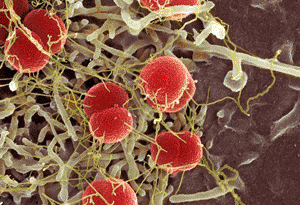Molecular Testing Aids Early Detection of Bacterial Meningitis
By LabMedica International staff writers
Posted on 08 Aug 2011
Molecular detection of Neisseria meningitidis in pediatric respiratory specimens might aid in the diagnosis of meningococcal disease (MD). Posted on 08 Aug 2011
Molecular polymerase chain reaction (PCR) testing identifies bacterial DNA and can detect both viable and nonviable organisms within a few hours, as compared to blood cultures that may take 48 hours.

Image: Colored scanning electron micrograph (SEM) of Neisseria meningitidis bacteria (red) on human epithelium (Photo courtesy of SPL).
An assessment of molecular testing for MD has been made at the Royal Victoria Hospital in Belfast (UK) and in other pediatric units in Northern Ireland. Scientists performed genotyping of respiratory swabs, blood, and cerebrospinal fluid (CSF) from children with suspected disease and nasal swabs from matched controls. Total nucleic acids were extracted from swab specimens, plasma, and CSF, using the protocol of the QIAamp DNA Blood BioRobot 9604 Kit (Qiagen; Crawley, UK). Meningococcal PCRs were performed on respiratory, CSF, and blood specimens using nested PCR and seminested PCR assays.
Of the 104 suspected cases of MD, 39 were confirmed with the disease and 4 of the controls identified as carriers. Throat swab testing for detection of disease gave a sensitivity of 81% and a specificity of 100%. Nasal swab testing gave a sensitivity of 51% and a specificity of 95% (62/65). Sequence-based genosubtyping was successful for all but two of the specimens that were initially positive. There was exact phylogenetic agreement from different specimen sites for individuals and the results from the different swab analysis had excellent concordance.
The study demonstrated that molecular testing of respiratory specimens for meningococci in a population of children with symptoms and signs suggestive of early MD performed well diagnostically, especially in comparison to culture of throat and blood specimens. In addition to the speed and sensitivity advantages of molecular techniques over culture, even greater time advantages are possible by utilizing single-round PCRs, which are more practical in a routine diagnostic laboratory setting and yield results within five hours. The study was published in August 2011 in Diagnostic Microbiology and Infectious Disease.
Related Links:
Royal Victoria Hospital
Qiagen













